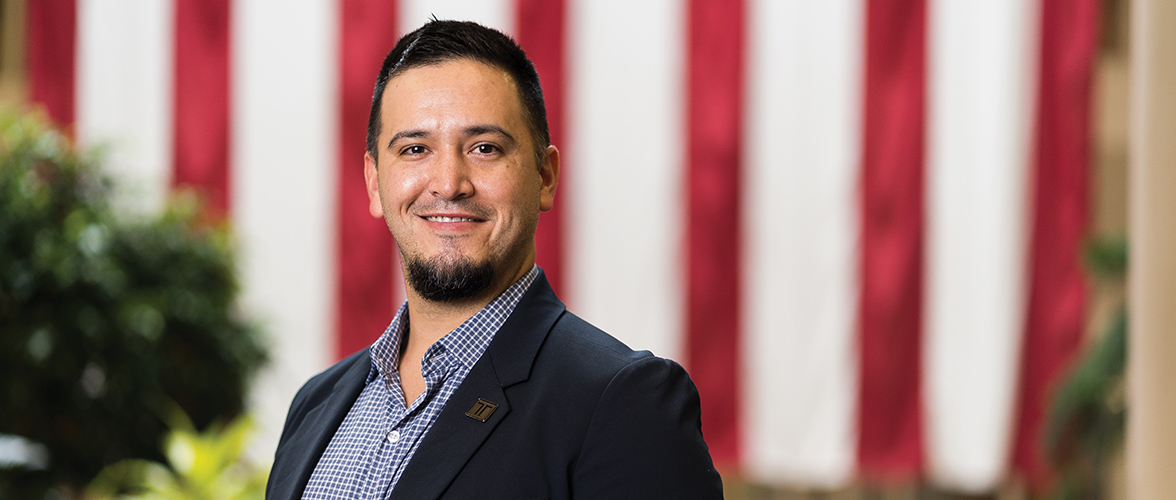A duty to care
The school’s rich history of military collaboration, innovation
September 15, 2019

Kirk Butler has seen the indelible scars of military combat up close. As a nurse and officer in the United States Army, Butler oversaw post-deployment reassessment of more than 4,000 soldiers at Joint Base Lewis-McChord near Tacoma, Washington. “I can’t tell you how many times I had to call the hospital about someone trying to take their life,” Butler said. “After that experience, that’s when I knew I needed to get back to soldier care and I needed to get back to the bedside. I needed to figure out a way to deal with these issues.”
Now Butler is pursuing a degree in the School of Nursing’s Doctor of Nursing Practice (DNP) nurse anesthesia program. As a certified registered nurse anesthetist, he plans to temper chronic pain that contributes to the higher prevalence of substance abuse disorders and mental health conditions among veterans.
Butler is grateful his journey led him to the University of Minnesota, where he’s leaned on support from the University Veterans Service office while gaining the education and experience to move into the next phase of his career. In the nurse anesthesia program, he’ll complete approximately 3,000 hours of clinical work by graduation, most of it at the Minneapolis Veterans Affairs Health Care System as part of a U.S. Department of Veterans Affairs scholarship program. It’s a setting that allows him to further his nursing skills while drawing on his military background.
“When I’m at the VA, I’m able to talk like, ‘Oh, what unit are you from? And where’d you come from? And what engagements have you served in?’” he said. “It’s easy to have that conversation, with almost immediate camaraderie.”
A history of collaboration, innovation
Examples of this history of collaboration and innovation between the school and military are easy to identify, whether it was during World War I, when the school trained Navy Corpsmen, or in World War II, when the school trained the largest group of nurses in the nation — 1,215 nurses — for the U.S. Cadet Nurse Corps.
“The school takes great pride in its history of preparing nurses for wartime duties,” said Christine Mueller, PhD, RN, FGSA, FAAN, senior executive associate dean for academic programs. “And we are grateful to have such a strong partner in the Minneapolis VA for clinical education.”
The partnership between the school and the VA to provide clinical education dates back to 1977 and continues today.
“The students are sharp as tacks and they know all of the latest literature and the latest medications and treatments. They help us be able to deliver world-class, cutting-edge care,” said Helen Pearlman, MS, RN, nurse executive for the Minneapolis VA Health Care System. “These partnerships with the School of Nursing are invaluable to the VA.”
The partnership to educate nurse anesthetists like Bulter began in 1996, when the Minneapolis VA entered into an agreement with the school to offer a master’s level program. By 2004 the VA School of Anesthesia became the University of Minnesota School of Nursing’s nurse anesthesia program, and, eventually, the partnership led to the first Doctor of Nursing Practice program in nurse anesthesia in the United States.
Clinical education was further enriched with the VA Nursing Academic Partnership (VANAP), a five-year program that allowed the school to increase the number of students in the Bachelor of Science in Nursing program, while providing specialized training about veterans’ health. As part of that program, the school strategically integrated veteran-centered health curriculum into the education that all Bachelor of Science in Nursing students receive. Health topics like PTSD, chemical exposure, amputation, traumatic brain injury and substance use disorder as they are experienced by veterans were integrated into the curriculum. “Everybody learned a great deal about veterans and their health care needs,” said Elaine Darst, PhD, APRN, PMHCNS-BC, LPCC, co-director of the BSN program and co-director of VANAP, who’s become a leader in veteran-centered health care curriculum and presented on the topic nationally and internationally. “To incorporate veteran-centered curriculum well, it was important to have a strong partnership with the VANAP leadership.”
‘A deep honor’
Recently, the Minneapolis VA, in partnership with the school, was one of 11 sites nationally selected to educate leaders and scholars in health care improvement to lead change nationally and internationally as part of the VA Quality Scholars Program. It is a two-year doctoral fellowship, with an emphasis on interprofessional, veteran-focused health care improvement. “Being able to participate in the health of our veterans is a deep honor,” said Clinical Associate Professor Judy Pechacek, DNP, CENP, RN, director of the DNP program, who is dedicating time at the VA as a senior quality scholar. “The common thread that you see and feel and hear when you’re at the VA is that everyone is there to serve veterans and they are humbled to be able to serve them. To participate with them in that mission is so aligned with the School of Nursing mission.”
For Butler, the longstanding partnership between the Minneapolis VA and School of Nursing has provided him with the foundation he needs to be a CRNA. “This is the path that I’ve always wanted to carve,” said Butler. “I wanted to do pain management, especially for veterans, and the University of Minnesota has such a strong emphasis on that. I’ve been incredibly fortunate to work with the staff of Minneapolis VA. So I’m excited to move into post-graduation and work as a nurse anesthetist in this field.”